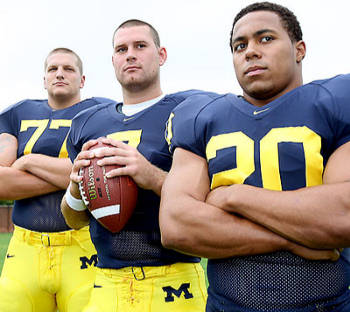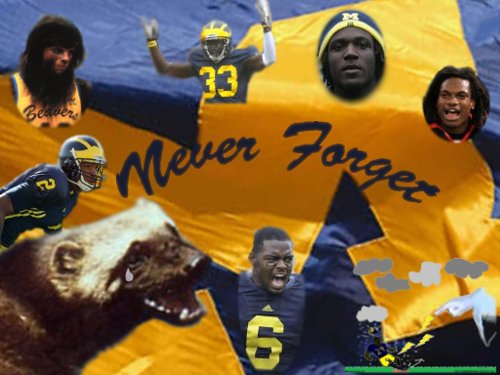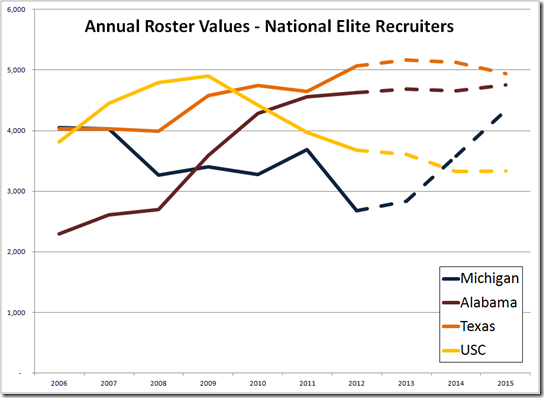recruiting is legit yo
Close followers of this site are well aware that for all his faults, Rich Rodriguez was not handed a classic, loaded Michigan roster when he arrived. If you followed his recruiting at all you know he didn’t do the Wolverines any favors with his recruiting during his three years in Ann Arbor. Based on 11 years of recruiting and roster history, I have compiled a look at how Michigan’s talent and experience have ebbed and flowed since 2006 and how many elite caliber classes like the currently assembled 2013 class it will take for Michigan’s talent base to catch up with the nation’s best recruiting programs.
For those interested in how the roster values were calculated, I’ve added a section to the end to explain the methodology.
The Lloyd Peak

How long before he retired he knew when the end was is hard to know, but Lloyd Carr certainly had the roster set up for a great 2006 and 2007. In 2006 Michigan entered the season with the highest rated roster in the Big Ten and trailed only LSU and Miami (YTM) for top marks nationally. Both sides of the ball were well represented, ranked third nationally on both offense and defense. The stacked lineup led Michigan to the brink of their first BCS National Championship game before losing to top ten talent teams in the final two games of the season.
After a disappointing finish to 2006, the roster was even more setup for a big send off for Lloyd Carr in 2007. The roster trailed only USC in terms of overall talent and the offense had a sizeable lead as #1 nationally. Unfortunately, the losses on the defensive side dropped the defense out of the top 10 and were exposed in the first two games, ending Michigan’s national title hopes before the calendar turned to October.
The RichRod Hangover

The 2008 version of Michigan was not a team lacking talent (except for quarterback), but it was a ways from the talent level in Ann Arbor the previous two seasons. The defense rose a bit to sneak back into the top 10, where the loss of the Henne/Hart/Long dropped the offense from #2 in the nation to #16. By the 2010 season things hadn’t gotten better but they hadn’t gotten worse, either. The offense and the defense consistently ranked in the top 15 nationally but the results, especially the GERG effect on the defense never matched up with the talent-level on campus. The roster left for Rodriguez didn’t do him any favors but it was also far above the record and defensive performances that came from it.
The High of Hoke…
…will have to wait. As great as the Hoke recruiting era has begun, it will likely be a few seasons before the dividends begin to payout. The next two seasons will be the two where the roster effects of the Three and Out era will come due. This season the talent level will drop down into the 20s overall and likely stay there for the 2013 season as well before a big jump two years from now when the majority of the Hoke classes move from observers to contributors.
Michigan Vs The Rivals
Michigan dominated the end of the Lloyd era versus all the big three rivals but by 2008 Ohio and Notre Dame both moved into a better roster position. Despite the head to head losses, Michigan maintained an overall roster advantage over Michigan State. That nearly closed over the next two seasons, before the Hoke recruiting pushed Michigan out front once again. By 2015 Michigan should move close to par with Ohio and Notre Dame for the first time since 2008.
Michigan Vs The Best
Despite a lull coming up over the next two seasons, Michigan is poised to move into the upper echelon of national programs in terms of overall program talent. If Michigan can maintain top 5 level classes, by 2015 Michigan will move into the elite group of rosters in the country. Michigan’s projections begin to look a lot like that opening day opponent, with a five year delay. Nick Saban had similar rosters his first two seasons that Michigan is facing in the coming years, before taking off into elite status. Hopefully Michigan doesn’t need to go through the roster manipulation to get there, but with the first two Hoke classes, Michigan is making the first step to achieve a similar roster look as the team that has won 2 of the last 3 national championships.
What it All Means
Even the most die-hard numbers guy like myself knows that at the end of the day these are just numbers on a computer screen and the game is played on the field. The numbers are far from everything. Coaching, luck, player development and other factors are all major contributors to team success. With that said, the composition of the roster does mean a lot. As far back as I have reliable data for roster composition (2005) only Auburn has won a National Championship and not been ranked in the Top 10 for roster talent, and it took one of the greatest individual single-season performances ever for that to happen. Conference championships can be won with middle of the road talent for the conference. Last year Wisconsin won the Big Ten with the 7th highest rated roster in the conference. But over the long haul talent will win out.
Michigan will have more to overcome in the talent department than at any other time in the internet era. 2012 and 2013 will be lean years by Wolverine standards. Thankfully, we have the kind of coaches that have a high likelihood of mitigating that drop through their other talents of player development, in game coaching and for the future with recruiting.
Methodology
Unlike Lindy’s I’ll do my best to give you a rundown of how I arrived at the valuations for each roster. Each player when recruited is ranked by each service. If they fall out of the Top X for any site, I do my best to approximate a ranking based on stars, position rank and grade where available. That rank is then translated into points. The formula I use is -4.5*ln([Rank]+11)+36. The specific formula was generated to more heavily weight the top players and produce an output where a consensus #1 rated prospect is worth a total of 99 points (summed across the four sites) and bottom of the barrel anonymous 2 stars are worth only a couple points.
Using this system, Michigan’s highest rated recruit was Prescott Burgess in 2003 at 90 points, Kyle Kalis was tops for the incoming class at 69 points and Shane Morris is currently at 79 points. Players are then weighted based on years in the system. Freshman only add 25% of their points to the roster total. 2nd year players (red-shirt freshmen or true sophomores) add 75% of their recruiting value to the overall total and all players in at least their third year in college football get 160% of their recruiting value. These numbers were derived based on actual usage of running backs (split of carries), quarterbacks (split of attempts), receivers (split of catches) and defenders (split of tackles) and then normalized so that the total roster number would approximately equal the sum of the unweighted recruiting points.
The total only counts players still on the roster at the beginning of the season. On the recruiting side a thousand points is usually at least a top ten or better class (The 2013 class is sitting at 1034 points). From the charts above you can see that the best rosters reflect 4-5 great classes and are 4-5,000 points.


31